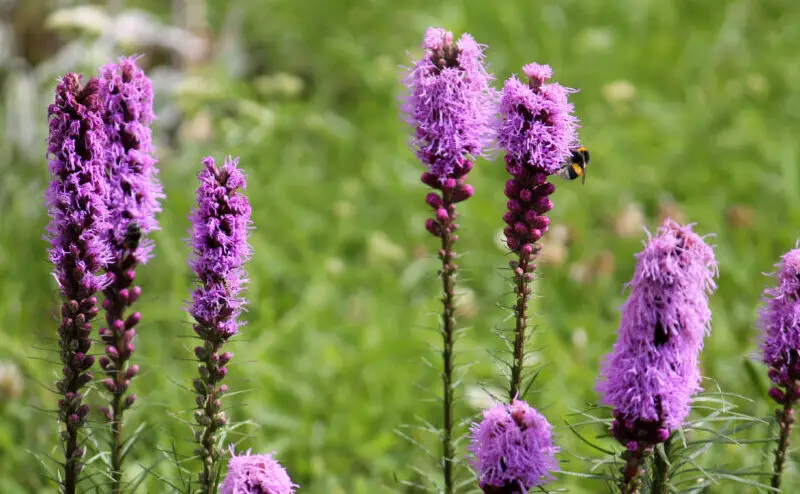Native to North America, Kansas Feather (Liatris spicata) is a hardy perennial in the Asteraceae family. Drought resistant, this rhizomatous plant produces elegant feathery melliferous flowers in flowerbeds.
Two to three feet tall, Liatris Spicata blooms from July to September, sometimes into October, offering fluffy purple-pink or white flowers depending on the variety.
Its leaves are long, narrow and linear but are not particularly interesting.
On the other hand, more surprising are the flower heads, grouped together on the whole height of a long flowering stem, which bloom first from the top. The flowers of the Kansas Feather are melliferous and attract pollinators, primarily butterflies.
Contents
Where to plant the bulb of Liatris Spicata?
Native to the eastern and central plains of the United States, Liatris or Kansas Feather acclimates without worry in all our gardens, resisting well to sub-zero temperatures down to at least 5°F.
If it prefers warm sunny exposures essential for an abundant bloom, it will tolerate the half-shade in the southern regions.
Easy to grow, it grows in light, sandy, even poor soil, cool to moist during the summer but well drained. The Liatris spicata has a preference for humid but not soaked soils and will appreciate the proximity of a pond or a water room where it will benefit from the ambient humidity. It fears heavy, compact and poorly drained soils in winter: a waterlogged soil would have reason for its resistance, its roots rot easily.
Taller than it is wide, it generally occupies 12 to 20 inches of width at maturity for a minimum height of 27 inches, offer it a place where it can give all its verticality.
Very graphic, the Latride composes a green and flowering bush all summer long, ideal to give relief, lightness and height to the backgrounds of slightly blurred summer beds, to large rock gardens or to mixed-borders. With its upright appearance, it has a very structuring power. It can also be grown in rows full of cut flowers or in pots for sunny terraces and balconies.
When to plant the bulb of Liatris Spicata?
The Liatris Spicata can be planted in spring from March to April or in autumn from September to November, outside the frosty periods.
How to plant the Liatris Spicata bulb?
In the ground (in bucket)
For a nice vaporous effect in a bed, plant liatris in groups of 5 to 7 per m2, spacing the plants 8 to 10 inches apart in all directions. To form a beautiful green bush with flowers all summer long in the middle of a grass for example, install at least ten Liatris plants. In heavy and compact soil, make a good contribution of compost to lighten it and improve the drainage.
- Dig a hole 2 to 3 times the volume of the bucket
- Spade the soil deeply to decompact the soil
- Add river sand or gravel to the bottom of the hole
- Add a good shovelful of compost
- Fill in
- Water copiously
- Mulch with compost to keep the roots cool during the summer
In a jar
The substrate should be very draining to avoid standing moisture. Plant Liatris Spicata in full sun in a large pot at least 20 inches in diameter in a mixture of garden soil and compost.
- Spread a good layer of gravel or clay balls at the bottom of the pot to facilitate drainage
- Plant the bucket straight up
- For bulbs, bury them 4 inches deep and cover them with three times their height of soil
- Mulch
- Water twice a week during the growing season
When and how to plant Liatris Spicata bulbs?
The roots of Liatris or Kansas Feather are similar to bulbs, they are located between the rhizome and the tuber. While the plant mostly comes in a bucket, Liatris Spicata bulbs are sometimes found commercially. Ideally, the plantation of the bulbs of Feathers of Kansas is carried out from September to November, except period of frost. A plantation in March is possible.
Maintenance and care of the Liatris Spicata bulb
Hardy and vigorous, Liatris spicata requires little care once well established in a well-draining soil.
Liatris spicata likes cool and even humid soils, do not hesitate to water it during dry summers. During the first few summers, give it regular waterings but without flooding it. Just make sure that the soil never dries out completely.
Mulch in May with a good layer of peat moss to keep the plant cool. Renew this mulch in the middle of the summer if necessary.
Remove with pruning shears the deflowered spikes as you go along to encourage a more vigorous regrowth next season: take advantage of this to compose fresh bouquets.
In autumn, cut off the wilted stems, cut back the old dry foliage to encourage the growth of new leaves or leave the dried spikes in place all winter and do this again in spring, in March.
All the aerial parts of the plant disappear in winter: mark its location with stakes if necessary to avoid damaging the clumps when digging and to facilitate the control of gastropods as soon as vegetation starts.
Division every 3-4 years allows keeping vigorous plants, liatris like many perennials, sometimes tends to decline after 2 or 3 seasons.
Diseases and pests of Liatris Spicata
The Liatris, Kansas Feather or Liatride is a rather resistant perennial. If the Liatris spicata appreciates a humid soil, be careful not to plant it with its feet in water, it would not resist it! It dreads heavy soils full of water in winter responsible for the rotting of the roots, if the soil is not sufficiently drained.
Young fresh shoots are threatened by slugs and snails at the start of vegetation. An anti-slug treatment, spread at planting, then every year from February is imperative. Protect it from their attacks with fern slurry, a beer bowl or ash barriers and get inspired by our slug traps and our 7 ways to fight slugs effectively and naturally.
Mice can nibble the roots of Liatris Spicata, which are similar to a bulb, difficult to fight if you do not have a cat, fortunately we will reveal some effective tips (wire basket, repellent plants …), to protect your bulbs from rodents.








